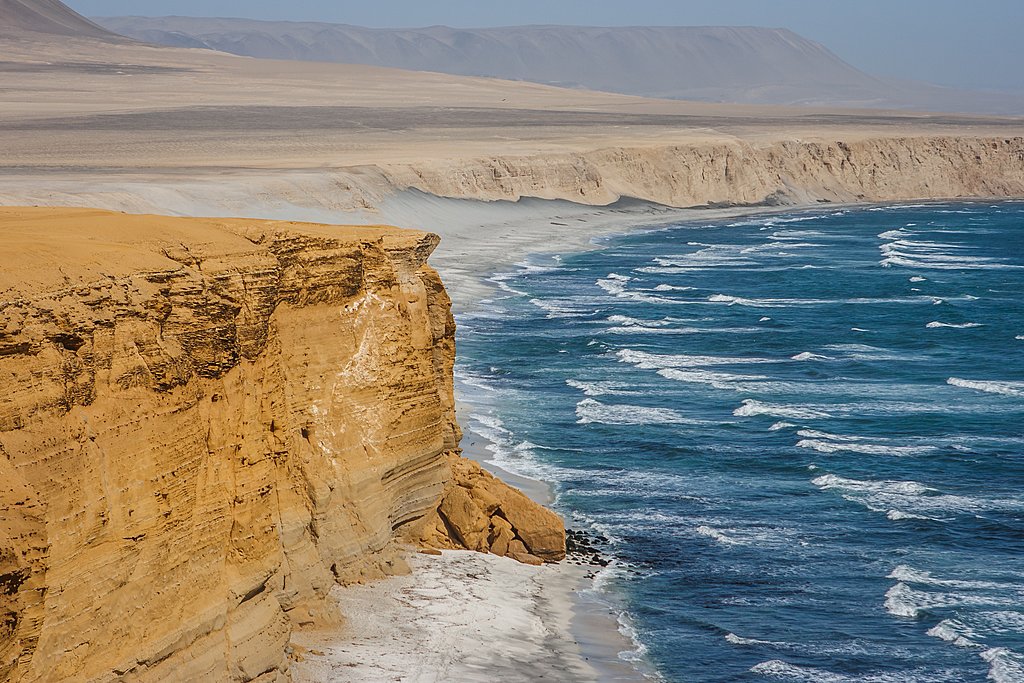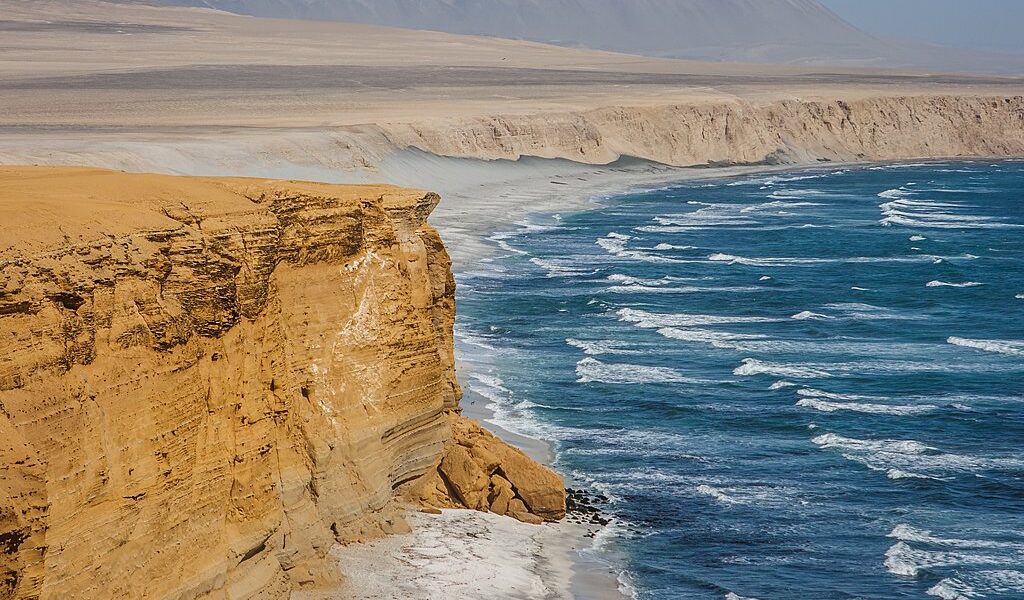
Though February tends to be the rainiest month in the Sacred Valley (the Inca Trail is completely closed), there’s a slew of lively highland festivals, alternative treks, and fun beach vibes along the country’s extensive Pacific coast. Find out what to do and where to go in this monthly guide.
Peru in February: A Comprehensive Travel Guide
February marks the height of summer in Peru, a land of striking contrasts and diverse landscapes. The weather in Peru during this time is as varied as its geography, presenting a unique experience depending on the region you choose to explore. To help you plan your Peruvian adventure, let’s delve into the distinct climate zones you can expect:
The Desert Coastal Strip: A Sunny Paradise
The desert coastal strip of Peru basks in pleasantly warm weather throughout February, characterized by abundant sunshine and minimal rainfall. This arid region encompasses popular destinations such as Mancora, Trujillo, Lima, Paracas, and Arequipa, offering ideal conditions for beachgoers and sun-seekers.
Near Lima, the coastline experiences average high temperatures of 79°F (26°C) and lows of 66°F (19°C), creating the perfect environment for swimming and water activities. These conditions make the beaches near Lima a particularly attractive option for those looking to escape the winter blues. Venturing south of Lima, you’ll encounter slightly cooler temperatures, offering a refreshing alternative while still enjoying the coastal scenery.
The Andean Zone or Highlands: A Warm and Wet Embrace
In contrast to the arid coast, the Andean zone, or highlands, experiences its warmest and wettest month in February. Temperatures in this region, which includes Huaraz, Machu Picchu, Cusco, and Lake Titicaca, fluctuate depending on the altitude, creating microclimates that add to the region’s allure.
If you’re planning a visit to the Cusco region, expect highs around 64°F (18°C) and lows around 43°F (6°C), accompanied by periods of light to heavy rains. While the precipitation might seem like a deterrent, don’t let it discourage you from exploring this remarkable region. The rain nourishes the landscape, resulting in lush flora and abundant fauna. Moreover, the showers are often interspersed with breaks in the clouds, offering glimpses of the majestic Andean scenery.
It’s worth noting that certain treks, such as the famed Inca Trail, may be closed for maintenance during this time of year. However, this doesn’t mean your trekking dreams are dashed. Numerous alternative routes offer equally stunning experiences.
The Amazonian Forest: A Tropical Downpour
The vast eastern area of Peru, covered by the Amazonian forest, presents a consistently warm and humid climate year-round, with February experiencing an increase in rainfall. This region includes destinations like Iquitos, Tarapoto, Manu, and Puerto Maldonado, each offering a unique gateway into the heart of the Amazon.
Near Iquitos, the Amazon jungle sees average highs of 90°F (32°C) and lows of 72°F (22°C), creating a truly tropical atmosphere. The typical pattern involves tropical rains occurring in the afternoon, often in the form of a refreshing downpour or a dramatic thunderstorm. These rains are essential for maintaining the biodiversity of the Amazon, and they add an element of excitement to any jungle excursion.
Crowds and Costs: Navigating the Seasonal Tides
The wet season in Peru’s interior and jungle regions coincides with a slowdown in tourism. Machu Picchu, for example, sees its lowest number of visitors in February, largely due to the muddy terrain in the Andes and Amazon. Some popular trails may also be closed for maintenance during this period, including the renowned Inca Trail.
However, this lull in tourism presents several advantages for intrepid travelers. Fewer visitors mean a more intimate and serene experience at popular sites. The scenery is also at its greenest, thanks to the abundant rainfall. Furthermore, you can often find lower rates for flights and hotels, making February a budget-friendly time to visit Peru. The mountains and canyons, often avoided by trekkers during this season, offer a sense of solitude for those seeking a tranquil escape.
Conversely, February is a prime time to visit Peru’s coastline. The coastal towns along the Pacific Ocean come alive with activity, offering a lively atmosphere, full-service beach facilities, and outdoor festivals. However, this popularity also means that February is one of the busiest (and most expensive) months along the coast.
Where to Go: Tailoring Your Itinerary
With such diverse options, deciding where to go in Peru during February requires careful consideration.
For sun-seekers, the Peruvian coastline is an obvious choice. The beaches south of Lima, including Punta Hermosa, Asia, Pulpos, Punta Negra, San Bartolo, and El Silencio, are popular destinations for locals and tourists alike. Further south lies the Paracas National Reserve, a stunning protected area featuring sand dunes, pristine beaches, and a diverse array of fauna. If you prefer a more laid-back atmosphere, head north to Máncora, a hideaway beloved by locals for its pristine beaches and chilled-out vibe. Nearby Las Pocitas offers a quieter alternative with some of the area’s finest hotels and resorts.
For those interested in exploring the heart of the Inca Empire, a visit to the Sacred Valley in Peru’s Andean highlands is highly recommended. The ancient city of Cusco and the iconic Machu Picchu are must-see destinations, despite the rain. Machu Picchu remains open in February, but the trails can be muddy and challenging for trekkers. The classic Inca Trail is closed this month, and the Huayna Picchu and Machu Picchu Mountain trails may also be periodically closed for maintenance.
As an alternative to the Inca Trail, consider the Salkantay Trek, a lesser-known 5-day trek to Machu Picchu. This route takes you past coffee farms, glacial lakes, and rugged snowcapped peaks before descending into the dense cloud forest that surrounds the Incan ruins.
Another alternative is the Cotahuasi Canyon Trek in the world’s deepest canyon. While likely to be wet, this canyon offers numerous trekking options, from one-day hikes to a six-day adventure.
If you’re looking to venture off the beaten path, consider exploring Northern Peru, a region often overlooked by tourists. Here, you’ll discover beautiful landscapes teeming with bird species, pre-Incan archaeological sites like the adobe city of Chan Chan, and a cloud forest ecosystem perfect for hiking and exploring lakes and waterfalls.
What to Do: A Range of Activities
Peru in February offers a wide range of activities to suit every interest.
Beaches & Watersports:
Locals flock to the beaches during the summer months, especially near Lima. Surfing is a growing sport in Peru, and many beach towns north of Lima, such as Cabo Blanco (home of the “Peruvian pipe”) and Chicama, offer excellent surf conditions through March, along with a relaxed vibe. Kiteboarding, stand-up paddleboarding, diving, and whale- and dolphin-watching are also popular activities along the coast.
Wildlife Viewing on the Ballestas Islands:
Accessible from the beach town of Paracas by tour boat, the Ballestas Islands, often called ‘the Galapagos Islands of Peru,’ are home to a remarkable variety of wildlife. Here, you can spot rare birds like pelicans, penguins, Peruvian boobies, and Inca terns. It’s also common to see sea lions, turtles, dolphins, and whales in the surrounding waters. The islands’ location on the Pacific coast makes them an ideal day trip destination while exploring the sand dunes of Huacachina.
Trekking:
While some trails may be closed for maintenance and heavy rains, Peru offers numerous trekking opportunities throughout the country. For shorter hikes, consider exploring the Day Hikes in the Sacred Valley near Cusco, offering breathtaking views and a chance to immerse yourself in the Andean landscape.
Sightseeing in Lima:
Despite the lack of rain, Lima is often overlooked in favor of Cusco. However, Peru’s capital is a vibrant city rich in history and culture. Explore its beautiful architecture, visit its cathedrals and museums, and discover its growing culinary scene, which includes two restaurants ranked among the World’s 50 Best Restaurants. Don’t forget to experience the city’s nightlife and shopping scene. Make sure to catch the sunset overlooking the bluffs at Miraflores for a truly unforgettable experience.
History & Inca Ruins:
The Sacred Valley is home to a wealth of Inca ruins, including Ollantaytambo, Sacsayhuaman, and Pisac, all located near the colonial city of Cusco. While these sites are more spread out than Machu Picchu, they offer a fascinating glimpse into the Inca civilization, alongside charming Spanish colonial villages and bustling handicraft markets.
Dig into Local Cuisine:
No trip to Peru is complete without sampling the local cuisine. The guinea pig dish called cuy is Peru’s most authentic culinary experience, often found in highland towns like Cusco and the Urubamba Valley. Other must-try dishes include fresh ceviche, stir-fried beef, and creamy chicken dishes. Potato dishes are ubiquitous, having been cultivated in the Andes for 10,000 years. Be sure to try the picarones, or Peruvian donuts, for a sweet treat.
February Events: Embracing Peruvian Culture
Peru is renowned for its numerous festivals, with thousands taking place throughout the country each year. Several notable events in February reflect the Roman Catholic calendar and are celebrated with great enthusiasm, particularly in indigenous highland villages, where Catholic feast days are often intertwined with traditional agricultural festivals.
Fiesta de la Candelaria:
Starting on February 2nd with a procession along petal-strewn streets, this popular 18-day highland festival, especially prominent in and around Puno on the shores of Lake Titicaca, features dance competitions, folkloric music, fireworks, and lively celebrations. While Puno is the epicenter, smaller processions also take place in many other parts of Peru.
Pisco Sour Day:
The first Saturday in February is El Día del Pisco Sour, or Pisco Sour Day, thanks to the Peruvian government. Expect to find various promotions, tastings, and other pisco-related events throughout the country.
Carnaval:
Held on the days leading up to Lent (in February or March), Carnaval is a popular celebration in the highlands, with Cajamarca hosting one of the largest festivities. Other hotspots include Puno and Ayacucho, as well as beach towns, where you’ll find parades, feasting, and colorful floats. This holiday is often celebrated with weeks of water fights (using buckets, not balloons), so it’s advisable to keep your car windows closed and protect your camera in a watertight bag. Unfortunately, crime tends to increase during the main Carnaval dates, so be vigilant about your belongings and watch out for pickpockets, especially in Lima.
Lunahuaná Adventure Sports Festival:
Typically commencing in late February, the Lunahuaná Adventure Sports Festival showcases the town’s growing adventure sports scene, particularly river running.
Festival del Verano Negro:
During the last week of February, Chincha, Peru’s cultural capital of African heritage, hosts the nation’s largest celebration of Afro-Peruvian culture, the Festival del Verano Negro. This two-week festival offers a vibrant celebration of Afro-Peruvian customs, with plenty of dancing, gastronomy, poetry competitions, and street parades.
This more detailed guide should assist you in planning an unforgettable trip to Peru in February. Remember to pack accordingly for the diverse climates and be prepared to embrace the cultural richness of this fascinating country.
B-2081

